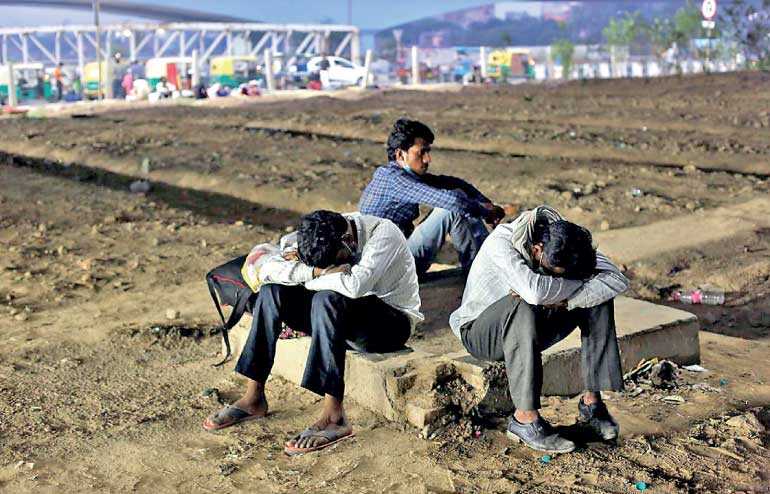Saturday Apr 05, 2025
Saturday Apr 05, 2025
Wednesday, 20 May 2020 00:05 - - {{hitsCtrl.values.hits}}

FILE PHOTO: Migrant workers rest as they wait to cross the border to reach their home state of Uttar Pradesh, during an extended nationwide lockdown to slow the spread of the coronavirus disease (COVID-19), on the outskirts of New Delhi, India - Reuters
NEW DELHI (Reuters): India’s $266 billion economic rescue package rests mostly on boosting company credit but contains scant new public spending, tax breaks or cash support to revive demand and prevent firms from collapsing, business leaders and economists say.
Businesses from airlines to small stores are reeling from Prime Minister Narendra Modi’s nearly two-month lockdown of India’s 1.3 billion people aimed at limiting the spread of the new coronavirus. Many firms say they won’t survive unless they are bailed out immediately.
The government said on Sunday it would privatise state-run companies in non-strategic sectors and stop fresh insolvency cases for a year. But apart from that its plans entail a mix of easy loan schemes, a bit more money for a rural job-guarantee program, and a slew of long-awaited policy reforms across sectors that will take effect over the medium-term.
Combined, this is not enough of a boost to prevent a likely 5% contraction in Asia’s third-largest economy in fiscal 2020/2021, Goldman Sachs said on Monday. It said it expected the economy to shrink an eye-watering 45% on an annualised basis in the quarter to the end of June.
Business leaders are unimpressed by the government’s response.
“We are creating all sorts of liquidity for supply, but what about the demand,” said Kiran Mazumdar Shaw, chairperson of Biocon Limited, one of the country’s top health firms.
“Demand is going to play a very big part in economic revival, and if we cannot kick-start demand I fear than we cannot have economic revival. I think we have lost a big opportunity,” she said.
A breakdown of the rescue plan shows that the actual spending of the government is only about a tenth of the $266 billion package, which Modi had hailed as 10% of India’s gross domestic product in line with the big stimulus plans announced by other major economies.
A large part of the rest of the package is actually loans provided by banks, many of them without collateral, leveraging $105 billion of liquidity provided by the central bank, government officials said.
“We would not qualify it as a stimulus package ... Only 1% of GDP is given to compensate for the income loss, which is not likely to be sufficient,” said Sunil Tirumalai of brokerage Emkay Global.
One percent of GDP would amount to about $29 billion – and the government may well spend even less than that as it fears a sovereign rating downgrade.
Govt. ‘has limited resources’
Two government officials said the government estimates total spending of $27 billion from the budget this year towards the rescue measures, which would prevent the fiscal deficit from widening more than 100 basis points beyond the target of 3.5% of GDP.
The finance ministry must also assess the scale of intervention required if the coronavirus pandemic drags on for longer than currently expected, officials said.
“We do not know how the situation would evolve or how long it will go on for. We need to prepare for that as well, as the government has limited resources and needs to spend wisely,” said one of the officials, who did not want to be named. Distress is mounting across the economy. Emkay estimated the cost of the lockdown at around $170 billion overall.
Indian airlines are taking an average daily loss of $10 million-$12 million and will need extra funding of 325 billion-350 billion rupees ($4.3 billion-$4.6 billion) in the next two years, according to ratings agency ICRA, a unit of Moody’s.
Airlines have been cutting staff and wages to avoid defaulting on debts to their lessors or banks, even as their fixed costs such as servicing and parking fees keep mounting.
The government has also provided no support to the tourism industry, which is likely to see tens of thousands of job cuts and small firms going bankrupt, the Federation of Associations in Indian Tourism & Hospitality said.
And a fifth of the 70 million retail traders who form the bedrock of Modi’s political support may go under because they are unable to pay wages and rent.
With the lockdown now extended to the end of May, only one thing seems certain: The road back to economic health is going to be long and hard.
“A steep fall in output this year is certain. And we continue to believe that the recovery will be slow,” said Shilan Shah from research firm Capital Economics.